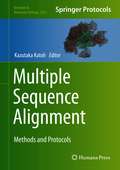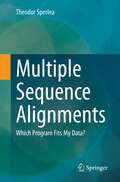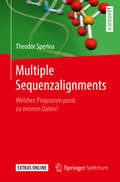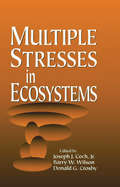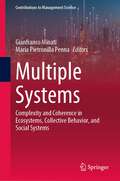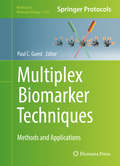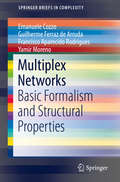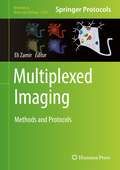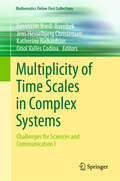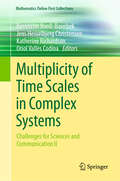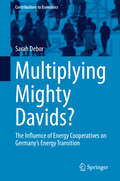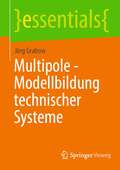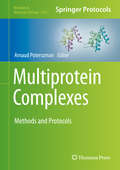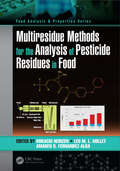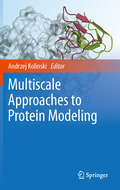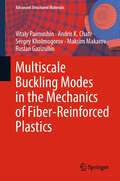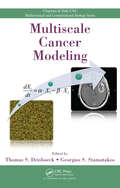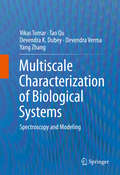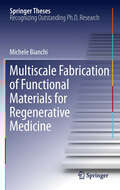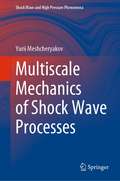- Table View
- List View
Multiple Sequence Alignment: Methods and Protocols (Methods in Molecular Biology #2231)
by Kazutaka KatohThis volume is a collection of protocols that discuss how to install and run tools for calculation and visualization of multiple sequence alignments (MSAs), and other analyses related to MSAs. Chapters cover basic MSA tools and specially designed tools to deal with new types of data resulting from recent developments in sequencing technologies. Written in the highly successful Methods in Molecular Biology series format, chapters include introductions to their respective topics, lists of the necessary materials and data, step-by-step, readily reproducible laboratory protocols, and tips on troubleshooting and avoiding known pitfalls.Cutting-edge and thorough, Multiple Sequence Alignments: Methods and Protocols is a valuable resource for experimental biologists who want to run MSA tools, and acquire basic and advanced information to further their understanding of the available technologies.
Multiple Sequence Alignments: Which Program Fits My Data?
by Theodor SperleaThis book is a practical guide for biologists who use multiple sequence alignments (MSAs) for their data analysis and are looking for a comprehensive overview of the many different programs. Despite their important role in data analysis, there is uncertainty among researchers about exactly how MSA programs work - not to mention how and why the different analyzes lead to different results. Which program is the right one for evaluating my data and how can I ensure that I have drawn all relevant findings from the alignments? This book offers helpful explanations and background information without requiring extensive bioinformatics knowledge and slowly introduces the reader to the topic.In the first part of the book, the possible fields of application as well as the formats that are usually produced by MSA programs are described in detail. The central algorithms as well as the internal processes of the most common MSA programs of the past and the present are also explained in an uncomplicated manner in greater detail. The second part of the book is a detailed, data-based comparison between MSA programs, which is intended to help you decide which program to use for your next alignment.
Multiple Sequenzalignments: Welches Programm passt zu meinen Daten?
by Theodor SperleaDieses Buch ist ein praktischer Ratgeber für Biologinnen und Biologen, die Multiple Sequenzalignments (MSAs) für ihre Datenanalysen verwenden und einen verständlichen Überblick über die vielen verschiedenen Programme suchen. Trotz ihres wichtigen Stellenwertes in der Datenanalyse herrscht Unsicherheit unter den Forschenden wie MSA-Programme genau funktionieren - ganz zu schweigen davon, wie und warum die unterschiedlichen Analysen zu verschiedenen Ergebnissen führen. Welches Programm ist für die Auswertung meiner Daten das richtige und wie kann ich sicherstellen, alle relevanten Erkenntnisse aus den Alignments gezogen zu haben? Dieses Buch bietet hilfreiche Erklärungen und Hintergründe ohne große bioinformatische Vorkenntnisse vorauszusetzen und führt die Leserinnen und Leser langsam in die Thematik ein.Im ersten Teil des Buches werden die möglichen Einsatzfelder wie auch die Formate, die üblicherweise von MSA-Programmen produziert werden, im Detail beschrieben. Ebenso werden auf unkomplizierte Weise die zentralen Algorithmen sowie die inneren Abläufe der gängigsten MSA-Programme der Vergangenheit und der Gegenwart in größerer Detailtiefe erklärt. Den zweiten Teil des Buches bildet ein ausführlicher datenbasierter Vergleich zwischen MSA-Programmen, der als Entscheidungshilfe für die Programmauswahl für dein nächstes Alignment dienen soll.
Multiple Stresses in Ecosystems
by Jr. Cech Barry W. Wilson Donald G. CrosbyEcotoxicology is the evaluation of toxic effects within the environment, typically within one specific ecosystem, like a forest, stream, or lake. For years now, ecotoxicological studies have tended to focus on one toxicant at a time. But that isn't how an ecosystem encounters toxicants (or stresses): there may be several elements at work in the air, several more in the water, and still more already within the soil of any given ecosystem, and all have some level of toxic influence on that ecosystem. Multiple Stresses in Ecosystems presents the state-of-the-art in determining the effects of these multiple impacts upon ecosystems.Resulting from a vanguard conference originally held in 1993 at UC Davis, this new work is divided into three sections that present methodolgies for assessing the health of an ecosystem; the effects of multiple toxicological impacts upon an ecosystem, and which tools are worth using to assess these dangers. Environmental scientists, chemists, toxicologists, risk analysts, and probably the entire membership of SETAC will find need for this book, as will wetlands scientists, ecologists, and research biologists.
Multiple Systems: Complexity and Coherence in Ecosystems, Collective Behavior, and Social Systems (Contributions to Management Science)
by Gianfranco Minati Maria Pietronilla PennaThis book presents the proceedings of the Eighth National Conference of the Italian Systems Society. The contributions underline the need for Systemics and Systems Science in order to address multiple, changing systems involving several coherent versions.The conference focused on identifying, discussing, and understanding possible interrelationships between fundamental theoretical advances in different disciplines. Given their scope, these proceedings represent a valuable asset for all researchers whose work involves multiple systems.
Multiple-Choice and Free-Response Questions in Preparation for the AP Computer Science Examination
by Leon SchramThe review concludes with a set of tricky questions, also known as snooker questions. A snooker question is a question that a student with good knowledge of a topic, nevertheless gets wrong. Therefore, we have devoted a large chapter for snooker questions. This new chapter covers 15 major topic areas that are tested on the AP Exam and provides two questions for each topic, to assist students with subtle trickiness in questions.
Multiplex Biomarker Techniques: Methods and Applications (Methods in Molecular Biology #1546)
by Paul C. GuestThis detailed book arrives as there is an increasing need for multiplex biomarker readouts for improved clinical management and to support the development of new drugs by pharmaceutical companies, due to continuous technical developments and new insights into the high complexity of many diseases. Chapters explore the basic technology platforms being applied in the fields of genomics, proteomics, transcriptomics, metabolomics, and imaging, which are currently the methods of choice in multiplex biomarker research. The book also describes the chief medical areas in which the greatest progress has been made and highlight areas where further resources are required. Written for the highly successful Methods in Molecular Biology series, methodology chapters include introductions to their respective topics, lists of the necessary materials and reagents, step-by-step, readily reproducible laboratory protocols, and tips on troubleshooting and avoiding known pitfalls. Multiplex Biomarker Techniques: Methods and Applications serves as an ideal resource for a wide variety of researchers interested in these vital multiplex techniques.
Multiplex Networks: Basic Formalism and Structural Properties (SpringerBriefs in Complexity)
by Emanuele Cozzo Guilherme Ferraz de Arruda Francisco Aparecido Rodrigues Yamir MorenoThis book provides the basis of a formal language and explores its possibilities in the characterization of multiplex networks. Armed with the formalism developed, the authors define structural metrics for multiplex networks. A methodology to generalize monoplex structural metrics to multiplex networks is also presented so that the reader will be able to generalize other metrics of interest in a systematic way. Therefore, this book will serve as a guide for the theoretical development of new multiplex metrics. Furthermore, this Brief describes the spectral properties of these networks in relation to concepts from algebraic graph theory and the theory of matrix polynomials. The text is rounded off by analyzing the different structural transitions present in multiplex systems as well as by a brief overview of some representative dynamical processes. Multiplex Networks will appeal to students, researchers, and professionals within the fields of network science, graph theory, and data science.
Multiplexed Imaging: Methods and Protocols (Methods in Molecular Biology #2350)
by Eli ZamirThis volume provides a collection of state-of-the-art approaches addressing key aspects of multiplexed imaging. Chapters focus on labeling and imaging techniques for multiplexed imaging, as well as on the application of these techniques for the study of cells and tissues. Written in the highly successful Methods in Molecular Biology series format, chapters include introductions to their respective topics, lists of the necessary materials and reagents, step-by-step, readily reproducible laboratory protocols, and tips on troubleshooting and avoiding known pitfalls. Authoritative and practical, Multiplexed Imaging: Methods and Protocols aims to be helpful for researchers interested in implementing multiplexed imaging or in developing novel, cutting-edge multiplexed imaging approaches.
Multiplicity of Time Scales in Complex Systems: Challenges for Sciences and Communication I (Mathematics Online First Collections)
by Bernhelm Booß-Bavnbek Katherine Richardson Jens Hesselbjerg Christensen Oriol Vallès CodinaThis highly interdisciplinary volume brings together a carefully curated set of case studies examining complex systems with multiple time scales (MTS) across a variety of fields: materials science, epidemiology, cell physiology, mathematics, climatology, energy transition planning, ecology, economics, sociology, history, and cultural studies. The book addresses the vast diversity of interacting processes underlying the behaviour of different complex systems, highlighting the multiplicity of characteristic time scales that are a common feature of many and showcases a rich variety of methodologies across disciplinary boundaries. Self-organizing, out-of-equilibrium, ever-evolving systems are ubiquitous in the natural and social world. Examples include the climate, ecosystems, living cells, epidemics, the human brain, and many socio-economic systems across history. Their dynamical behaviour poses great challenges in the pressing context of the climate crisis, since they may involve nonlinearities, feedback loops, and the emergence of spatial-temporal patterns, portrayed by resilience or instability, plasticity or rigidity; bifurcations, thresholds and tipping points; burst-in excitation or slow relaxation, and worlds of other asymptotic behaviour, hysteresis, and resistance to change. Chapters can be read individually by the reader with special interest in such behaviours of particular complex systems or in specific disciplinary perspectives. Read together, however, the case studies, opinion pieces, and meta-studies on MTS systems presented and analysed here combine to give the reader insights that are more than the sum of the book’s individual chapters, as surprising similarities become apparent in seemingly disparate and unconnected systems. MTS systems call into question naïve perceptions of time and complexity, moving beyond conventional ways of description, analysis, understanding, modelling, numerical prediction, and prescription of the worldaround us. This edited collection presents new ways of forecasting, introduces new means of control, and – perhaps as the most demanding task – it singles out a sustainable description of an MTS system under observation, offering a more nuanced interpretation of the floods of quantitative data and images made available by high- and low-frequency measurement tools in our unprecedented era of information flows.
Multiplicity of Time Scales in Complex Systems: Challenges for Sciences and Communication II (Mathematics Online First Collections)
by Bernhelm Booß-Bavnbek Katherine Richardson Jens Hesselbjerg Christensen Oriol Vallès CodinaNote to the interested reader to have a look at the companion to this volume Challenges for Sciences and Communication I | ISBN: 978-3-031-28048-1.This highly interdisciplinary volume brings together a carefully curated set of case studies examining complex systems with multiple time scales (MTS) across a variety of fields: materials science, epidemiology, cell physiology, mathematics, climatology, energy transition planning, ecology, economics, sociology, history, and cultural studies. The book addresses the vast diversity of interacting processes underlying the behaviour of different complex systems, highlighting the multiplicity of characteristic time scales that are a common feature of many and showcases a rich variety of methodologies across disciplinary boundaries. Self-organizing, out-of-equilibrium, ever-evolving systems are ubiquitous in the natural and social world. Examples include the climate, ecosystems, living cells, epidemics, the human brain, and many socio-economic systems across history. Their dynamical behaviour poses great challenges in the pressing context of the climate crisis, since they may involve nonlinearities, feedback loops, and the emergence of spatial-temporal patterns, portrayed by resilience or instability, plasticity or rigidity; bifurcations, thresholds and tipping points; burst-in excitation or slow relaxation, and worlds of other asymptotic behaviour, hysteresis, and resistance to change. Chapters can be read individually by the reader with special interest in such behaviours of particular complex systems or in specific disciplinary perspectives. Read together, however, the case studies, opinion pieces, and meta-studies on MTS systems presented and analysed here combine to give the reader insights that are more than the sum of the book’s individual chapters, as surprising similarities become apparent in seemingly disparate and unconnected systems. MTS systems call into question naïve perceptionsof time and complexity, moving beyond conventional ways of description, analysis, understanding, modelling, numerical prediction, and prescription of the world around us. This edited collection presents new ways of forecasting, introduces new means of control, and – perhaps as the most demanding task – it singles out a sustainable description of an MTS system under observation, offering a more nuanced interpretation of the floods of quantitative data and images made available by high- and low-frequency measurement tools in our unprecedented era of information flows.
Multiplying Mighty Davids?: The Influence Of Energy Cooperatives On Germany's Energy Transition (Contributions to Economics)
by Sarah DeborThis book systematically describes and evaluates the impact of energy cooperatives as a key driving force in the German energy transition toward a sustainability-oriented energy sector. Based on a comprehensive survey and three case studies, it provides an instructive overview of the overall dimensions and scope of energy cooperatives in Germany, and of their history, structure and current investment projects. The book not only contributes to the energy policy discourse in Germany, but also highlights the role of energy cooperatives to enable an international readership to explore their potential in other countries. Further, it makes a theoretical contribution toward substantially supplementing actor research in general, and enterprise research in particular, in the field of sustainability transitions science.
Multipole - Modellbildung technischer Systeme (essentials)
by Jörg GrabowDas vorliegende essential beschreibt einen allgemeingültigen, strukturierten Modellbildungsprozess für technische Systeme (Mechatronische Systeme) auf Basis von Multipolen. Die Verschiedenheit physikalisch-technischer Teilsysteme macht zunächst unterschiedliche Ordnungskriterien physikalischer Grundgrößen notwendig. Auf Grundlage dieser Ordnungskriterien werden anschließend allgemeingültige, physikalische Basisgrößen eingeführt, welche im Weiteren zu unabhängigen Teilsystemen erweitert werden. Abschließend erfolgt eine Verkopplung der unabhängigen Teilsysteme in Form von Multipolen über die Methoden der Netzwerkanalyse. Kurze Beispiele zu den jeweiligen Teilkomplexen ergänzen die theoretischen Ausführungen an geeigneter Stelle.
Multiprobe Pressure Analysis and Interpretation (Advances in Petroleum Engineering)
by Wilson ChinA popular 1990s formation tester with a single "pumping" probe and one passive "observation port" displaced 180 deg away, designed to measure pressures at two locations for permeability prediction, encounters well known detection problems at low mobilities. This book, using aerodynamics methods, explains why and also reveals the existence of a wide stagnation zone that hides critical formation details. And it does much more. An exact analytical solution is used to validate a new transient, three-dimensional, finite difference model for more general testers, one that guides new hardware designs with independent azimuthally displaced probes having with different rates, flow schedules and nozzle geometries, supports interpretation and formation evaluation, and assists with job planning at the rigsite. The methods also apply to conventional tools, allowing comparisons between older and newer technologies. Importantly, the authors introduce a completely new three-probe design with independently operable active elements that eliminate all older tool deficiencies. Numerous subjects are discussed, such as pressure transient analyses with multiple operating probes, supercharge analysis with invasion and mudcake buildup, accurate and rapid calculations that allow more than 1,000 simulations per minute, extremely rapid batch mode calculations using convergence acceleration methods, rapid fluid withdrawal with minimal dissolved gas release, dip angle, heterogeneity and anisotropy evaluation, and many other topics. In addition, tool operation sequences, detailed engineering and design functions, field test procedures and laboratory facilities, are discussed and illustrated in photographs that go "behind the scenes" at one of the world’s largest international oil service companies. The book hopes to educate new engineers and veteran engineers alike in hardware and software design at a time when increasing efficiency is crucial and "doing more with less" represents the new norm.
Multiprotein Complexes: Methods and Protocols (Methods in Molecular Biology #2247)
by Arnaud PoterszmanThis volume explores strategies and detailed protocols for the preparation of macromolecular complexes and their characterization in view of structural analysis. The chapters in this book are separated into three parts: Part One focuses on sample preparation, and covers strategies for recombinant expression of multiprotein complexes in prokaryotic and eukaryotic hosts, for genome engineering using the CRISPR/Cas9 system and for production of specific binders such as reformatted antibodies and artificial binding proteins. Part Two looks at the biophysical methods that can provide useful indicators for sample optimization, and often complement structural information obtained with core technologies for structure determination—x-ray crystallography and cryo-electron microscopy—by quantitative solution data. Part Three discusses the characterization of multiprotein complexes in a cellular environment using the latest technologies and in vivo approaches. Written in the highly successful Methods in Molecular Biology series format, chapters include introductions to their respective topics, lists of the necessary materials and reagents, step-by-step, readily reproducible laboratory protocols, and tips on troubleshooting and avoiding known pitfalls.Cutting-edge and authoritative, Multiprotein Complexes: Methods and Protocols is a valuable resource for structural and molecular biologists who need to prepare multi-components for their applications, and for other scientists working on macromolecular assemblies from other angles that need to know the latest approaches that the field has to offer.
Multiquark Hadrons
by Luciano Maiani Ahmed Ali Antonio D. PolosaThis work summarises the salient features of current and planned experiments into multiquark hadrons, describing various inroads to accommodate them within a theoretical framework. At a pedagogical level, authors review the salient aspects of quantum chromodynamics (QCD), the theory of strong interactions, which has been brought to the fore by high-energy physics experiments over recent decades. Compact diquarks as building blocks of a new spectroscopy are presented and confronted with alternative explanations of the XYZ resonances. Ways to distinguish among theoretical alternatives are illustrated, to be tested with the help of high luminosity LHC, electron-positron colliders, and the proposed Tera-Z colliders. Non-perturbative treatments of multiquark hadrons, such as large N expansion, lattice QCD simulations, and predictions about doubly heavy multiquarks are reviewed in considerable detail. With a broad appeal across high-energy physics, this work is pertinent to researchers focused on experiments, phenomenology or lattice QCD.
Multiresidue Methods for the Analysis of Pesticide Residues in Food (Food Analysis & Properties)
by Leo M.L. Nollet Horacio Heinzen Amadeo R. Fernandez-AlbaIn the last decades the public concern on the pesticide residues content in foods have been steadily rising. The global development of food trade implies that aliments from everywhere in the world can reach the consumer`s table. Therefore, the identification of agricultural practices that employ different pesticides combinations and application rates to protect produce must be characterized, as they left residues that could be noxious to human health. However, the possible number of pesticides (and its metabolites of toxicological relevance) to be found in a specific commodity is almost 1500, and the time needed to analyze them one by one, makes this analytical strategy a unrealistic task. To overcome this problem, the concept of Multi Residue Methods (MRM) for the analysis of pesticide traces have been developed. The advent of new and highly sensitive instrumentation, based in hyphenatedchromatographic systems to coupled mass analyzers (XC (MS/MS) or MSn) permitted simultaneously the identification and the determination of up to hundreds of pesticide residues in a single chromatographic run. Multiresidue Methods for the Analysis of Pesticide Residues in Food presents the analytical procedures developed in the literature, as well as those currently employed in the most advanced laboratories that perform routinely Pesticide Residue Analysis in foods. In addition to these points, the regulations, guidelines and recommendations from the most important regulatory agencies of the world on the topic will be commented and contrasted.
Multiscale Approaches to Protein Modeling
by Andrzej KolinskiThe book gives a comprehensive review of the most advanced multiscale methods for protein structure prediction, computational studies of protein dynamics, folding mechanisms and macromolecular interactions. It approaches span a wide range of the levels of coarse-grained representations, various sampling techniques and variety of applications to biomedical and biophysical problems. This book is intended to be used as a reference book for those who are just beginning their adventure with biomacromolecular modeling but also as a valuable source of detailed information for those who are already experts in the field of biomacromolecular modeling and in related areas of computational biology or biophysics.
Multiscale Biomechanics and Tribology of Inorganic and Organic Systems: In memory of Professor Sergey Psakhie (Springer Tracts in Mechanical Engineering)
by Valentin L. Popov Georg-Peter Ostermeyer Evgeny V. Shilko Olga S. VasiljevaThis open access book gathers authoritative contributions concerning multiscale problems in biomechanics, geomechanics, materials science and tribology. It is written in memory of Sergey Grigorievich Psakhie to feature various aspects of his multifaceted research interests, ranging from theoretical physics, computer modeling of materials and material characterization at the atomic scale, to applications in space industry, medicine and geotectonics, and including organizational, psychological and philosophical aspects of scientific research and teaching as well. This book covers new advances relating to orthopedic implants, concerning the physiological, tribological and materials aspects of their behavior; medical and geological applications of permeable fluid-saturated materials; earthquake dynamics together with aspects relating to their managed and gentle release; lubrication, wear and material transfer in natural and artificial joints; material research in manufacturing processes; hard-soft matter interaction, including adhesive and capillary effects; using nanostructures for influencing living cells and for cancer treatment; manufacturing of surfaces with desired properties; self-organization of hierarchical structures during plastic deformation and thermal treatment; mechanics of composites and coatings; and many more. Covering established knowledge as well as new models and methods, this book provides readers with a comprehensive overview of the field, yet also with extensive details on each single topic.
Multiscale Buckling Modes in the Mechanics of Fiber-Reinforced Plastics (Advanced Structured Materials #207)
by Vitaly Paimushin Andris K. Chate Sergey Kholmogorov Maksim Makarov Ruslan GazizullinThis book is a useful source of knowledge for engineers and scientists in the field of mechanics of deformation and destruction of composite materials. In Chapter 1 three-dimensional equations of elasticity theory composed for the case of finite displacements and deformations of solids have been analyzed. It is found that the generally accepted simplifications known in the literature and carried out for the case of small deformations result in equations that are considered to be absolutely correct and consistent in all scientific and educational literature on mechanics of deformable solid bodies. However, this conclusion is not sufficiently well-founded as confirmed by formulation and solution of problems on the basis of generally accepted equations for determining both the stress-strain state (SSS) and the critical loads and buckling modes. In Chapter 2 the theoretical and experimental methods for determining the mechanical characteristics of fiber-reinforced plastics (FRPs) based on tensile and compression tests of flat specimens with [0]s , [±90]s, and [±45]2s lay-ups are analyzed. For FRPs with [±45]2s lay-ups, relations are derived for determining the components of lamina strains and stresses in the orthotropy axes of FRP monolayer in terms of axial strains and Poisson ratios of specimens measured in experiments. In Chapter 3 the structure of a unidirectional fibre composite of two types ELUR-P carbon fibre based on KhT-118 cold-curing binder and HSE 180 REM prepreg based on hot-curing binder has been studied. The diameters of fibres and fibre bundles (filaments) of both types of composites have been measured. Based on the results of the analysis of the composite material structure, a refined formulation of the linearised problems of a refined statement of linearized problems on flat internal multiscale buckling modes of a rigid lamina with either fibers or a fiber bundle is presented taking into account their interaction with an epoxy matrix. In Chapter 4 for shells of a layered structure based on the Timoshenko’s model, taking into account the transverse compression used for each layer, two versions of two-dimensional equations are constructed that describe geometrically nonlinear deformation with arbitrary displacements and small deformations. The formulation of a linear problem on the initial (subcritical) stress-strain state of a test specimen from a unidirectional fibrous composite with the [900]s structure during tension-compression tests with shear is given. A numerical method for solving the formulated problem is developed, which is based on the reduction of the original problem to a system of integro-algebraic equations and the search for their numerical solution by the finite sum method. In Chapter 5 conclusions were done and directions for further research have been identified.
Multiscale Cancer Modeling (Chapman & Hall/CRC Mathematical Biology Series)
by Thomas S. Deisboeck Georgios S. StamatakosCancer is a complex disease process that spans multiple scales in space and time. Driven by cutting-edge mathematical and computational techniques, in silico biology provides powerful tools to investigate the mechanistic relationships of genes, cells, and tissues. It enables the creation of experimentally testable hypotheses, the integration of dat
Multiscale Characterization of Biological Systems
by Yang Zhang Vikas Tomar Tao Qu Devendra K. Dubey Devendra VermaThis book covers the latest research work done in the area of interface mechanics of collagen and chitin-based biomaterials along with various techniques that can be used to understand mechanics of biological systems and materials. Topics covered include Raman spectroscopy of biological systems, scale dependence of the mechanical properties and microstructure of crustaceans thin films as biomimetic materials, as well as the role of molecular-level modeling. The use of nanomechanics to investigate interface thermomechanics of collagen and chitin-based biomaterials is also covered in detail. This book also: * Details spectroscope experiments as well as nanomechanic experiments * Reviews exhaustively phenomenological models and Raman spectroscopy of biological systems * Covers the latest in multiscaling for molecular models to predict lab-scale sample properties and investigates interface thermomechanics
Multiscale Computer Modeling in Biomechanics and Biomedical Engineering
by Amit GefenThis book reviews the state-of-the-art in multiscale computer modeling, in terms of both accomplishments and challenges. The information in the book is particularly useful for biomedical engineers, medical physicists and researchers in systems biology, mathematical biology, micro-biomechanics and biomaterials who are interested in how to bridge between traditional biomedical engineering work at the organ and tissue scales, and the newer arenas of cellular and molecular bioengineering.
Multiscale Fabrication of Functional Materials for Regenerative Medicine
by Michele BianchiRegenerative medicine demands new concepts and fabrication tools to improve our common knowledge about cell-cell and cell-environment interactions. In this work, Michele Bianchi shows that different kinds of signals, such as chemical, topographical, and electrical signals, can be arranged in a highly-controlled way. Furthermore, Michele uses scale lengths ranging from several micrometers to a few nanometers, through the employment of unconventional fabrication techniques. For each signal, Michele chose properly designed materials and fabrication methods. The external signals are capable of controlling cell adhesion and growth, opening the way for a systematic investigation of the environmental features affecting cell behaviour.
Multiscale Mechanics of Shock Wave Processes (Shock Wave and High Pressure Phenomena)
by Yurii MeshcheryakovThis book presents theoretical and experimental investigations of mechanical behavior of solids under shock loading and highlights a multi-scale exchange process of energy and momentum between meso and macroscopic hierarchy. It also widely covers experimental approaches for the multi-scale response of solids to impacts including uniaxial strain conditions and high-velocity penetration processes. The content comprises two parts. The first part overviews modeling and theory of dynamically deformed solids from the multi-scale point of view. The second part describes experimental characterization of shock-induced solids and experimental probing of mesostructured and mesoscale dynamic processes in solids. The theory presented in the first part is then verified as it is compared with i) experiments of shock loading into different kinds of solids and ii) probed microstructure of post-shocked specimens by scanning electron microscopy, transmission electron microscopy and optical microscopy.The text is written on the basis of author’s lectures at universities and thus is concisely described for postgraduate students. It is also useful for researchers who work on the theory of multi-scale mechanics of solids and engineers who work on testing materials under dynamic loading.
